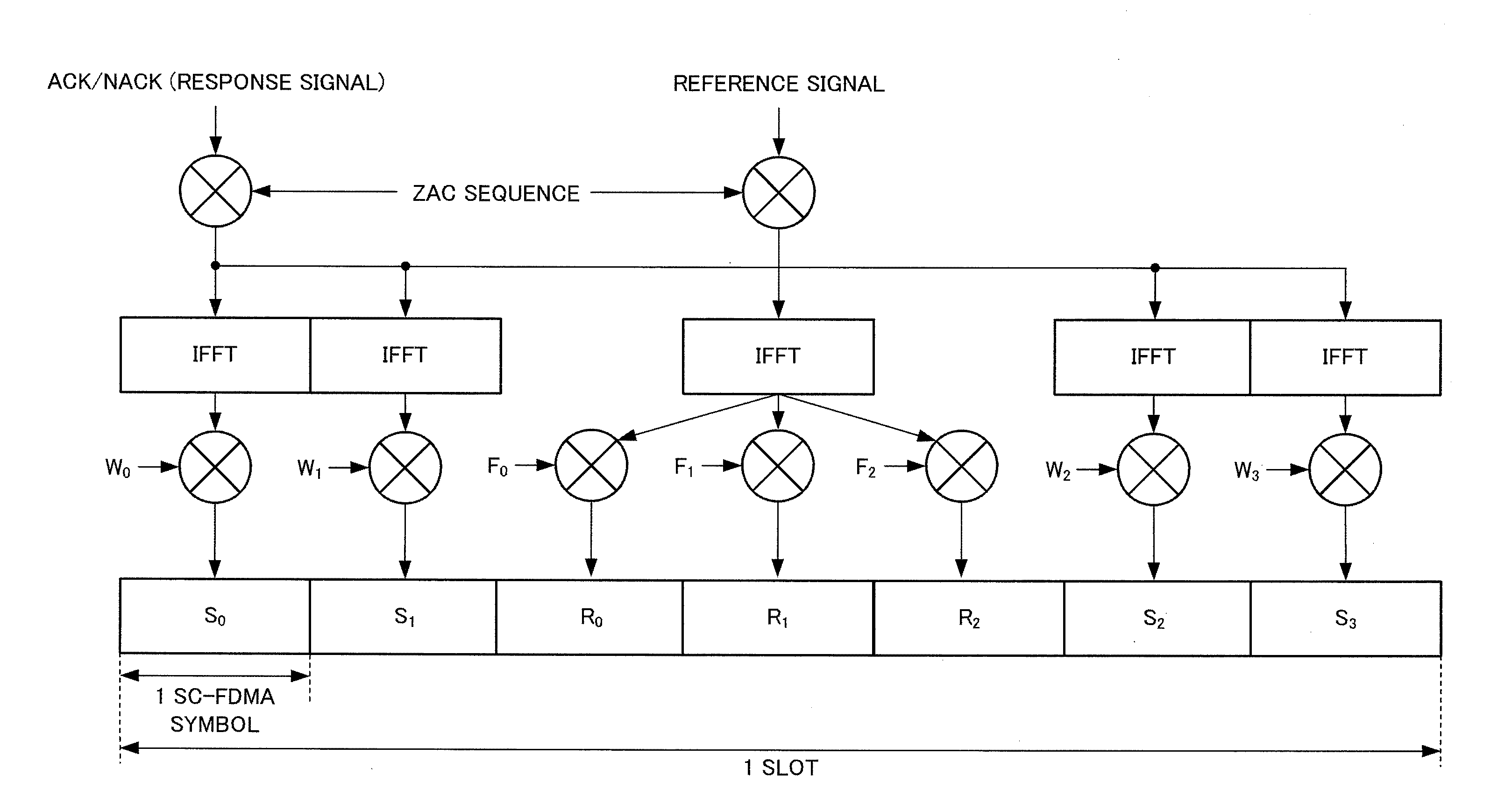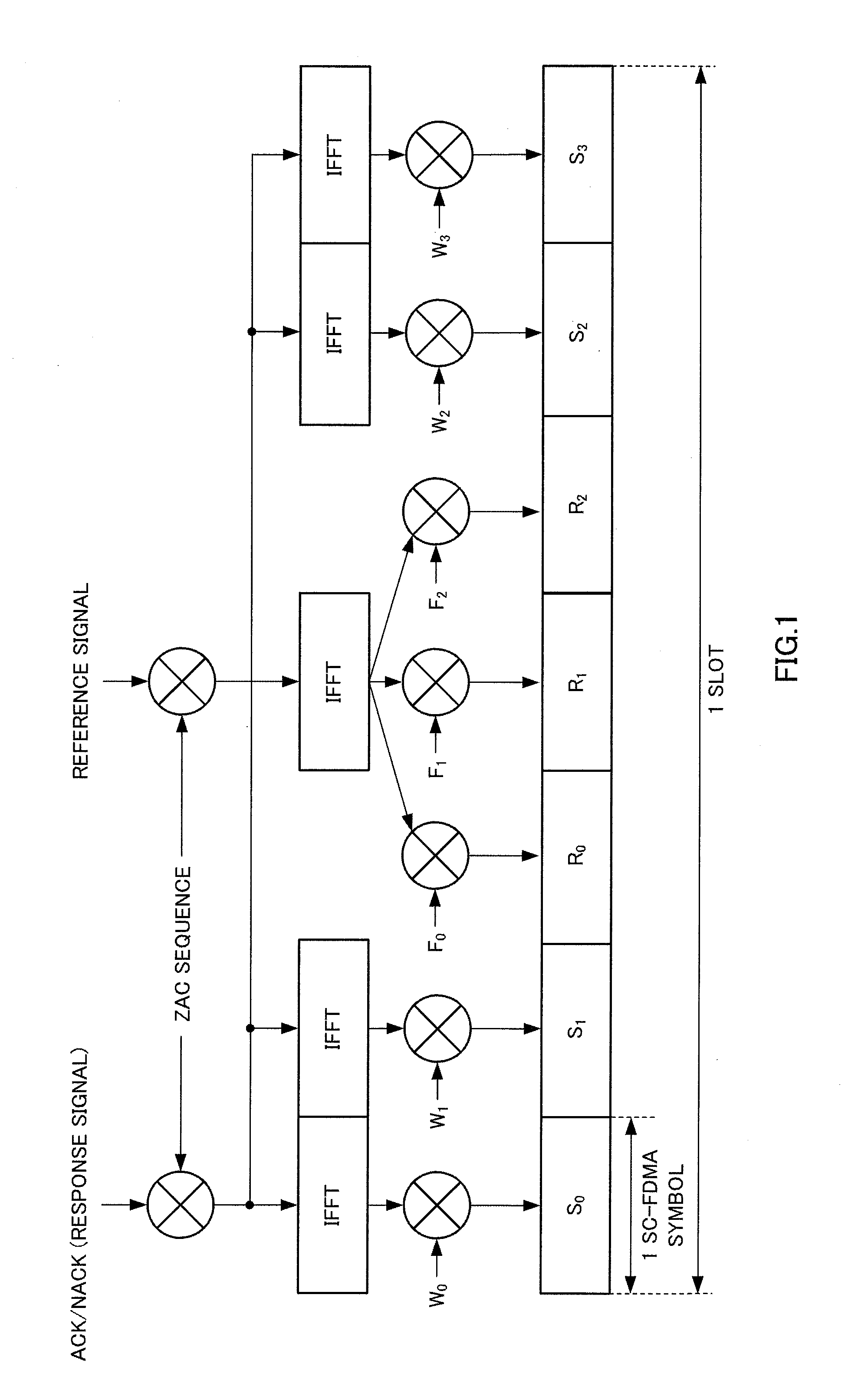Radio communication device and constellation control method
a technology of radio communication and constellation control, applied in the direction of multi-channel communication, wireless communication, transmission path sub-channel allocation, etc., can solve the problem of one response signal being interfered, and achieve the effect of improving the error rate performance of a nack
- Summary
- Abstract
- Description
- Claims
- Application Information
AI Technical Summary
Benefits of technology
Problems solved by technology
Method used
Image
Examples
embodiment 1
[0052]FIG. 5 illustrates the configuration of base station 100 according to the present embodiment, and FIG. 6 illustrates the configuration of mobile station 200 according to the present embodiment.
[0053]Here, to avoid complicated explanation, FIG. 5 illustrates components associated with transmission of downlink data and components associated with reception of uplink response signals to the downlink data, which are closely related to the present invention, and illustration and explanation of the components associated with reception of uplink data will be omitted. Similarly, FIG. 6 illustrates components associated with reception of downlink data and components associated with transmission of uplink response signals to the downlink data, which are closely related to the present invention, and illustration and explanation of the components associated with transmission of uplink data will be omitted.
[0054]Also, a case will be described with the following explanation, where ZAC sequen...
embodiment 2
[0126]With the present embodiment, Embodiment 1 is implemented only in a specific slot among a plurality of slots forming one subframe.
[0127]For example, when one subframe is formed with two slots of slot #0 and slot #1, the constellation of the first response signal group and the constellation of the second response signal group are both constellation #1 (in FIG. 3 and FIG. 4) in slot #0, while, as in Embodiment 1, the constellation of the first response signal group is constellation #1 (in FIG. 3 and FIG. 4) and the constellation of the second response signal group is constellation #2 (in FIG. 8 and FIG. 9) in slot #1. By this means, it is possible to improve the error rate performance of an ACK in slot #0.
[0128]Therefore, according to the present embodiment, by adjusting the number of specific slots in which a constellation is inverted (as in Embodiment 1), it is possible to easily adjust both the NACK error rate and the NACK error rate according to the target error rate.
[0129]Al...
embodiment 3
[0130]With the present embodiment, for example, while the constellation is inverted in cell #1 as shown in FIG. 7, the constellation is inverted in cell #2 adjacent to cell #1 as shown in FIG. 11. Therefore, for example, referring to PUCCH #1, while constellation #2 (in FIG. 8 and FIG. 9) is used for PUCCH #1 in cell #1, constellation #1 (in FIG. 3 and FIG. 4) is used for PUCCH #1 in cell #2. Similarly, referring to PUCCH #2, while constellation #1 (in FIG. 3 and FIG. 4) is used for PUCCH #2 in cell #1, constellation #2 (in FIG. 8 and FIG. 9) is used for PUCCH #2 in cell #2.
[0131]That is, with the present invention, further to Embodiment 1, between two adjacent cells, the constellation of one of two response signals subject to first spreading by ZAC sequences of the same cyclic shift value, is inverted with respect to the constellation of the other response signal.
[0132]By this means, between a plurality of adjacent cells, it is possible to randomize interference between a plurality...
PUM
 Login to View More
Login to View More Abstract
Description
Claims
Application Information
 Login to View More
Login to View More - R&D
- Intellectual Property
- Life Sciences
- Materials
- Tech Scout
- Unparalleled Data Quality
- Higher Quality Content
- 60% Fewer Hallucinations
Browse by: Latest US Patents, China's latest patents, Technical Efficacy Thesaurus, Application Domain, Technology Topic, Popular Technical Reports.
© 2025 PatSnap. All rights reserved.Legal|Privacy policy|Modern Slavery Act Transparency Statement|Sitemap|About US| Contact US: help@patsnap.com



